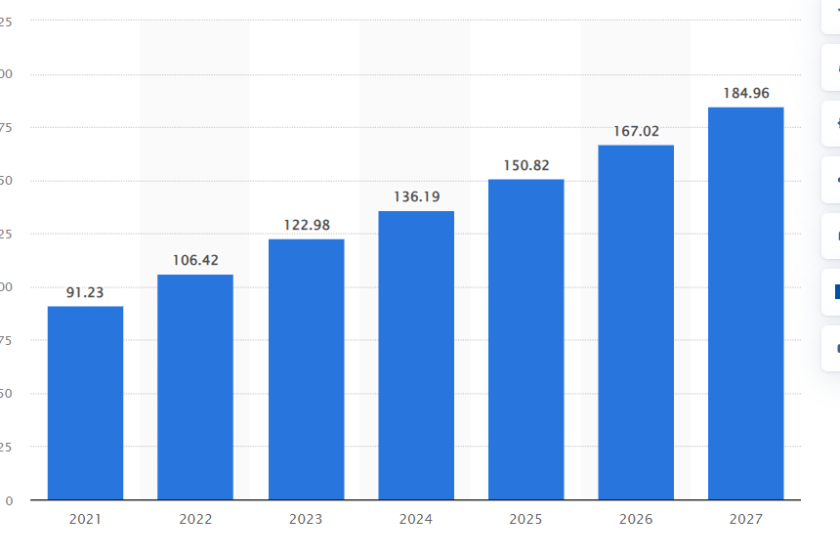The apparel and textile industry presents a substantial market opportunity, with the global apparel market reaching a staggering USD 1.5 trillion in 2023 and projected to reach a value of USD 2.2 trillion by 2030, reflecting a healthy CAGR of 5.2%.
Growth Factors in Apparel Industry
- Rising Disposable Income: A burgeoning global middle class with increased spending power fuels demand for new clothing and textiles, creating a favorable market environment for B2B suppliers (World Bank).
- Evolving Consumer Preferences: Consumers today prioritize comfort, sustainability, and personalization in their apparel choices, demanding innovative solutions from B2B partners (McKinsey & Company). This shift presents an opportunity for companies specializing in sustainable materials, design software, and customized production techniques.
- Technological Advancements: Automation in manufacturing, digital printing techniques, and online sales platforms are revolutionizing the way clothes are produced, distributed, and sold. B2B solution providers specializing in automation equipment, digital printing technologies, and e-commerce platforms are well-positioned to capitalize on this trend.
Key Players in the Global Apparel Industry
The global apparel industry boasts a diverse landscape of players, with established brands, agile fast-fashion companies, and innovative B2B solution providers shaping the market. Here’s a glimpse at some of the key players:
- Nike (USA): A global leader in sportswear and athletic apparel.
- Inditex (Spain): Parent company of Zara, a fast-fashion giant known for its trendy and affordable clothing.
- LVMH (France): A luxury fashion powerhouse owning brands like Louis Vuitton, Dior, and Christian Dior.
- H&M (Sweden): A major player in the fast-fashion segment known for its trendy and affordable styles.
- Adidas (Germany): A leading sportswear brand known for its innovative footwear and apparel.
Apparel Industry Challenges
Despite the promising outlook, the apparel industry faces significant challenges that players must navigate:
- Intense Competition: The market is saturated with fast-fashion brands vying for consumer attention, leading to price wars and pressure on profit margins (Bloomberg). B2B solution providers can help by offering cost-effective production solutions, improved supply chain management strategies, and innovative marketing tools.
- Ethical Concerns: Issues like labor exploitation and environmental pollution in the supply chain are attracting increased scrutiny. B2B players can demonstrate a commitment to ethical sourcing and sustainable practices, fostering trust and brand loyalty (Fashion Revolution). Transparency and traceability throughout the supply chain will be critical for success.
- Supply Chain Disruptions: Global disruptions due to pandemics and geopolitical conflicts can cause shortages and price fluctuations (International Monetary Fund). B2B solution providers can play a key role in mitigating these risks by offering diversified sourcing options, fostering strong supplier relationships, and implementing robust logistics strategies.
Apparel Industry Outlook
Market research suggests key trends that B2B players can leverage to thrive in the future:
- Sustainability Focus: Eco-friendly practices like using organic cotton and recycled materials will be increasingly prioritized (Textile Exchange). B2B solution providers can offer sustainable materials, efficient production processes, and recycling technologies to help brands meet these demands.
- Personalization: Consumers are craving more customized clothing options (Accenture) [9]. B2B players can offer design software, production platforms, and logistics solutions that enable brands to provide made-to-order and customized clothing options.
- Omnichannel Retailing: Seamless integration between online and offline shopping experiences will become crucial for retailers. B2B solution providers can develop omnichannel retail technologies and support brands in creating a unified shopping experience.
Conclusion
The apparel and textile industry is poised for continued growth, with innovation and collaboration at the forefront. By understanding these market insights and trends, B2B players can develop solutions that address industry challenges, promote sustainability, and empower brands to thrive in the ever-evolving fashion landscape. By working together, the industry can create a more sustainable and profitable future for all stakeholders.

